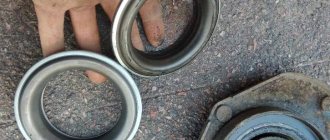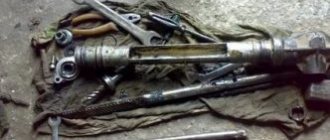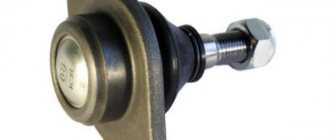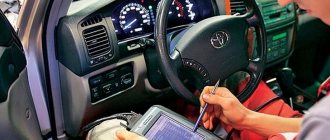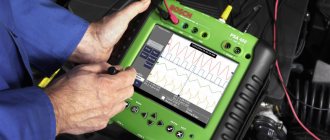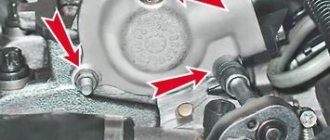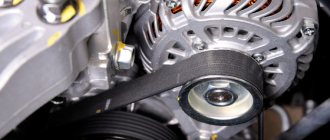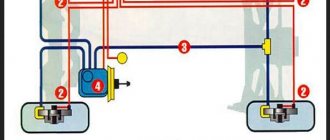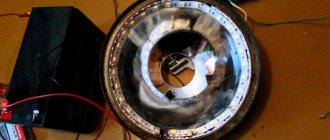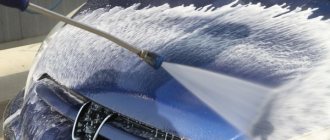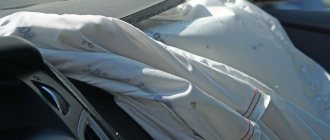Structurally, the rear suspension of the car is much simpler than the front. However, this does not mean that there is nothing to knock there. A knocking sound in the rear suspension usually becomes heard at the moment when repairs are required. In the front chassis you can feel the feedback on the steering wheel, pedals, body, and the sounds are closer. In the rear, the sounds are transmitted into the trunk, where it is difficult to hear them. And when the driver needs to transport something long and the seats are folded, then the knocking becomes clearly noticeable and the understanding comes that there is a problem. And if the type of knock in the front suspension is not difficult to understand what happened to the car, then in the case of the rear suspension, diagnosis is more difficult. But you can understand the reason.
The easiest and most reliable way to diagnose a knock in the rear suspension is manually, but this is only if it is not possible or you do not want to go to a service station. There are also diagnostic stands that will accurately identify any suspension problems. You shouldn’t drive with knocks, although the rear suspension may not seem particularly important - in the future this can lead to undesirable consequences.
What to check first?
You should start self-diagnosis not with the rear suspension, but with the exhaust system. The exhaust tract should be checked from beginning to end. Very often, the cause of a clunking rear suspension is in the muffler and not somewhere else. To do this, the car is driven into a pit or raised on a lift, and the fasteners and all parts of the exhaust system are carefully checked. Next, pump the exhaust pipe. If it doesn't make any sounds or hit the bottom, then everything is fine and you can move on.
Next, check the trunk. Experts recommend paying special attention to the spare wheel mounting points. An instrument can get into the niche and cause sounds similar to the knocking of a suspension. But if these checks did not yield anything, then you need to move on and diagnose the elements of the rear chassis.
Other reasons
If diagnostics have been started and no obvious problems have been identified, you can pay attention to the following:
- A brake caliper is an element of the brake system, which, when the pedal is pressed under the influence of the created pressure in the brake hydraulic system (mechanical and electronic are quite rare), compresses the wearing pads. In some cases, misalignment is possible, due to which the pads will wear unevenly and a knock may appear during braking. You can check the caliper visually, as it should also have no defects.
- The hub or bearings are a common problem that leads to humming and knocking noises while driving. To check, the brake disc or drum must be removed. If installed bearings are severely damaged during dismantling, they spill out or have defects that can be identified visually. The bearing mounting method is pressing. That is why, when it gets wedged, the hub can wear out, as evidenced by the bearing turning. You can determine problems with the hub or bearings without dismantling work, for which you need to slightly rock the wheel to the side.
- Another sign is a loose wheel. Wheel rims need to be balanced.
Diagnostics of the vehicle elements listed above in this paragraph should be carried out periodically, since their failure will lead to brake failure or loss of controllability (there are known cases when the hub bursts due to severe overheating, as a result of which the wheel can jam at speed).
Checking the levers
The car is driven into the pit and a gear is installed at the gearbox - in this case it is better not to use the handbrake. For diagnostics you will need a mount. With its help, the serviceability of silent blocks and bushings in the levers is checked. If there is play, then the bushings need to be changed.
The suspension arms need to be checked for integrity. Often these parts become deformed when driving. This can lead to a knocking sound in the rear suspension. Cracks will indicate the need for urgent replacement of the levers. The fasteners of the levers may loosen during driving - if this is the case, then they are tightened.
Deformed levers may knock on the body when driving. Other parts in the rear suspension also make noise. This is determined by the rocking of the car.
This simple diagnostic method by swinging allows you to quickly and without serious costs obtain the most complete information about the condition of the suspension. But you shouldn’t expect a miracle - a car won’t always reveal all its secrets so easily. It happens that you can hear a knock from the rear suspension while driving, but in a pit or at a service station you can’t hear anything.
Consequences of ignoring a knock
Any extraneous sounds that appear while driving must be identified without delay, as their presence may indicate a serious malfunction. In this case, let’s look at the consequences of knocking in the rear suspension:
- If problems arise in the guides and are not resolved in a timely manner, in addition to material costs, controllability may deteriorate; in some cases, this malfunction leads to a situation where the suspension is secured only by a spring and a shock absorber. The result is wear and tear of all elements, creating an emergency situation.
- If the spring is damaged, the car sways on uneven roads. In addition, the spring does not limit the movement of the shock absorber. The result of spring wear is terrible stability of the car on the road and damage to other suspension elements.
- Failure of shock absorbers is accompanied by a constant knocking sound. As a result, severe wear occurs on the fastening elements, as well as the shock absorbers themselves. In this case, controllability deteriorates significantly, and strong roll is possible when turning at high speed.
In most cases, a knock in the rear suspension is detected almost immediately, as it occurs while overcoming a bump or pothole on the road. As a rule, suspension elements fail after their service life has expired. If you replace parts in a timely manner, you can avoid road accidents and serious material costs.
Checking racks and supports
If the racks make a strange sound, this can be determined quite simply. When the car is rocked, you need to place the wooden handle of the hammer against the stand and feel if the knock is heard on the object. You may hear deformed or sagging springs. Loose strut mounts can also actually make knocking noises.
There are also problems in the upper mount of the rack. The top mount is broken - this can be seen from the trunk. You need to place your finger on the mount and then rock the car up and down. If the lower fastening has lost its elasticity, this is checked in approximately the same way, but this time on the pit from below - a finger is applied to the fastening from below.
The stand itself may also fail. This is determined when all other options for the appearance of knocking in the rear suspension are excluded. Then you need to change the shock absorber on the car.
Next, check the springs - they can make a variety of sounds. The coils hit each other, there are various problems that lead to spring breakage. To carry out a full diagnosis, you need to disassemble the parts, but this is usually done when nothing else helps. Pay attention to the integrity of the rubber gaskets, which are sometimes installed on the upper and lower parts of the spring from the factory. They smooth out impacts on the body during suspension operation. If there are no such elements, it is likely that the sounds arise precisely because of this.
It often happens that a knock in the rear suspension appears only when driving, but when diagnosed, everything is in perfect order. Then the spring needs to be disassembled.
Diagnostics of the anti-roll bar
If damaged, the stabilizer bracket can also make various sounds. Its design is represented by two silent blocks, which are connected by a narrow metal beam. This is what breaks most often. On uneven surfaces of the body, the rubber-metal joints interact with each other, producing a metallic crunch.
You can determine the damaged part of the bracket by tugging one of the ends of the stabilizer. To most accurately assess the condition of the stabilizer, it is necessary to turn the steered wheels from side to side.
Brake calipers
This situation is possible on some car models with rear disc brakes. The reason is unscrewing or play in the calipers. This is a common problem for budget car models. It is inexpensive fasteners that often lead to parts failure. Often such knocks are very difficult to diagnose. You will have to perform a whole series of operations.
The first step is to pull the caliper with your hands while the wheel is screwed on. There is a chance that these parts are hitting the brake disc. But everything must be tightly tightened. Then they remove the wheel and carry out manual diagnostics of all caliper fastenings - they pull the mechanism with their hands and check for play.
Next, the caliper is disassembled to identify loose parts. Particular attention should be paid to the quality of tightening of each module and element, each bolt. This may suggest the nature and cause of the knocking noises. You also need to pay attention to the brake pads - perhaps they are worn out or deformed and knock in their place when driving.
In the case of drum brakes, everything is much simpler. None of the elements in this mechanism can provoke knocking. This is only possible when the drum has crumbled. But there is no need to discount the brakes, especially if you hear a knocking sound in the rear suspension when braking. The pads have already been discussed and now we need to look at the situation more deeply.
Spring problem
Although springs are very durable, they can also wear out over time under certain operating conditions. Often, spring wear manifests itself in a slightly different way: the car wobbles at high speed, strong rocking, or a sagging rear end. However, when looking for something that may be knocking, you can conduct a visual inspection and pay attention to the following points:
- Do the turns have any defects?
- Are the rubber pads intact?
In most cases, springs lose their elasticity due to long service life or when exposed to heavy loads (for example, a passenger car has been used for a long time to transport a heavy load). The appearance of defects in the turns indicates poor quality of the metal used in manufacturing, a manufacturing defect, or severe wear. If everything is in order, we carry out further inspection.
Shock absorbers: a common problem caused by rough roads.
Shock absorbers can be considered the most vulnerable structural element. They are designed to absorb impacts when overcoming broken sections of the road. You can determine shock absorber wear as follows:
- Visually - if a clear oil leak appears, as indicated by oil stains, this structural element must be replaced or repaired.
- Completely disassemble the shock absorber. To do this it is necessary to dismantle them. There are rubber bushings inside the shock absorber that often fail. The problem with shock absorbers manifests itself when overcoming bumps. There may also be poor vehicle stability when driving at high speed. It is worth considering that the method is only suitable for serviced shock absorbers.
What else could be knocking?
There are also the most incredible causes of knocking noises that drivers have been looking for for many years and cannot find. If there is even a slight knock in the rear suspension, it will intensify over time and it can be localized. But it’s worse when this knock doesn’t change. Additional checks are needed.
Often the reason is a wheel that has come loose after a tire service. There may also be metal parts in the trunk that knock two against each other - in the cabin it seems that this is a knock in the suspension. The spare tire may knock against the housing for it. The body itself may also be knocking. And the muffler – it vibrates often.
The service station is the first to check all these reasons. This way you can understand where the rear suspension knocking on small bumps comes from when driving, without even moving on to diagnosing the suspension. You just need to normally look for the reason and have more information on how to solve problems.
Let's sum it up
There are many interesting options for car repair. Among them there is also self-diagnosis. This is a great advantage for every owner that you can do your own research on the car, detect problems, and go to the service already prepared for all the nuances. Our modern service stations do not always tell the truth about problems, make incorrect diagnoses and make money out of the blue. This is why there is an outflow of customers to garage foremen. Sometimes the latter offer much better quality of services.
There are indeed many complex elements in the rear suspension, and sometimes it is very difficult to diagnose. But in fact, you just need to gain a little experience in order to more or less understand the details of the chassis. This will help you simply carry out the necessary actions and get a more or less good inspection of the car yourself. If you have a master whom you completely trust, it is better to contact such a specialist. This will help you find the cause much faster and perform high-quality repairs in a matter of hours. How do you prefer to detect the causes of knocking noises in your car's suspension?
